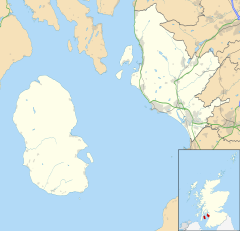Dalry, Ayrshire
Dalry
|
|
|---|---|
| Dalry shown within North Ayrshire | |
| Population |
5,398 (2001 census) |
| OS grid reference | NS290497 |
| Council area | |
| Lieutenancy area | |
| Country | Scotland |
| Sovereign state | United Kingdom |
| Post town | DALRY |
| Postcode district | KA24 |
| Dialling code | 01294 |
| Police | Scottish |
| Fire | Scottish |
| Ambulance | Scottish |
| EU Parliament | Scotland |
| UK Parliament | |
| Scottish Parliament | |
5,398 (2001 census)
Dalry (/dælˈraɪ/) is a small town in the Garnock Valley in Ayrshire, Scotland. Drakemyre is a northern suburb.
Dalry (from Scottish Gaelic Dail Ruighe, meaning 'the haugh at the slope') is a small settlement on the Rye Burn. Its history has signs of early inhabitants in the area. The remains of an ancient fort made of three concentric round walls can be found on the summit of Carwinning Hill to the North of Dalry, west of the B784 to Largs. In 1883 excavations by John Smith of caves in the Dalry Blair estate at Cleeves Cove cave found evidence of prehistoric man and otter bones.
Aitnock fort at the SW angle of Hindog Glen was excavated by John Smith in 1901-2, it showed a possible dun occupying the summit of a cliff which rises about 60 feet (18 m) perpendicularly from the Rye Water. He stated in "Excavations of the forts of Castlehill, Aitnock and Coalhill, Ayrshire" it was defended on one side by the steep drop to the Rye and by a horse shoe shaped deep ditch and stone walls.
The interior was about 30 ft in diameter, the floor had been leveled, then covered with yellow clay over which a pavement of rough slabs and river pebbles were laid. On the pavement was an accumulation of deposits, in some places 6ins deep, in and on which the relics were found… coins, stone objects, a glass bead, 1st or 2nd century Samian bowl fragments, burnt bones and iron objects. A sandstone cauldron was found near the centre of the interior, close by was a fireplace of slabs set on edge, this he states was possibly used to heat the water in the cauldron. An irregular lump of sandstone was found, bearing two chiseled cup marks one on each side, almost opposite each other. During his excavations he found 4 silver Roman coins, all denarii, two of Antoninus Pius and one each of Vespasian and Hadrian, all of which came from parts of an upper black layer of occupation. Smith's collection of material from here was donated to the National Museum of Antiquities of Scotland in 1981.
...
Wikipedia

